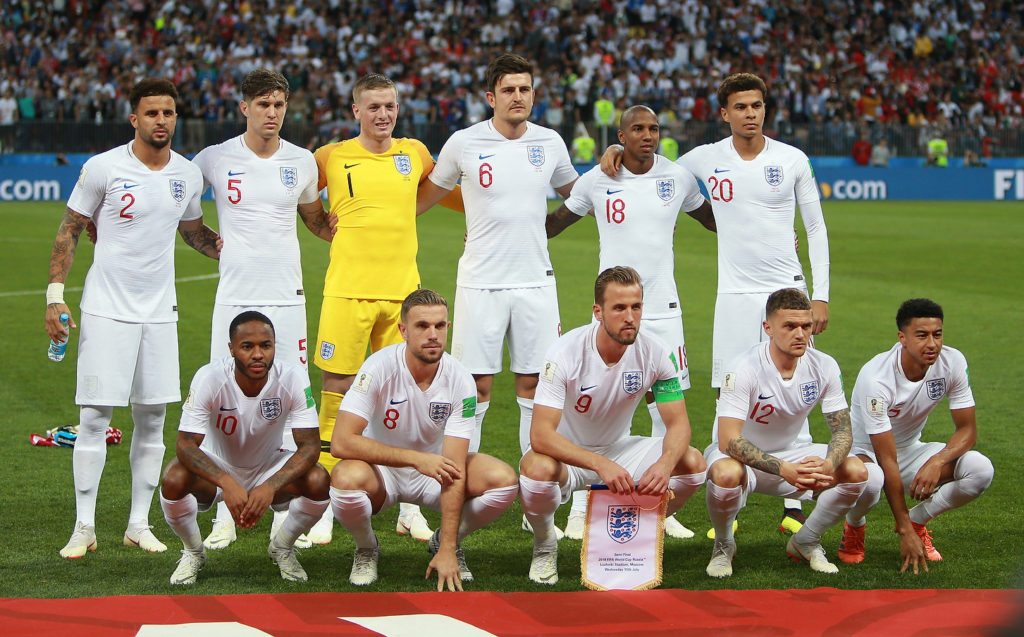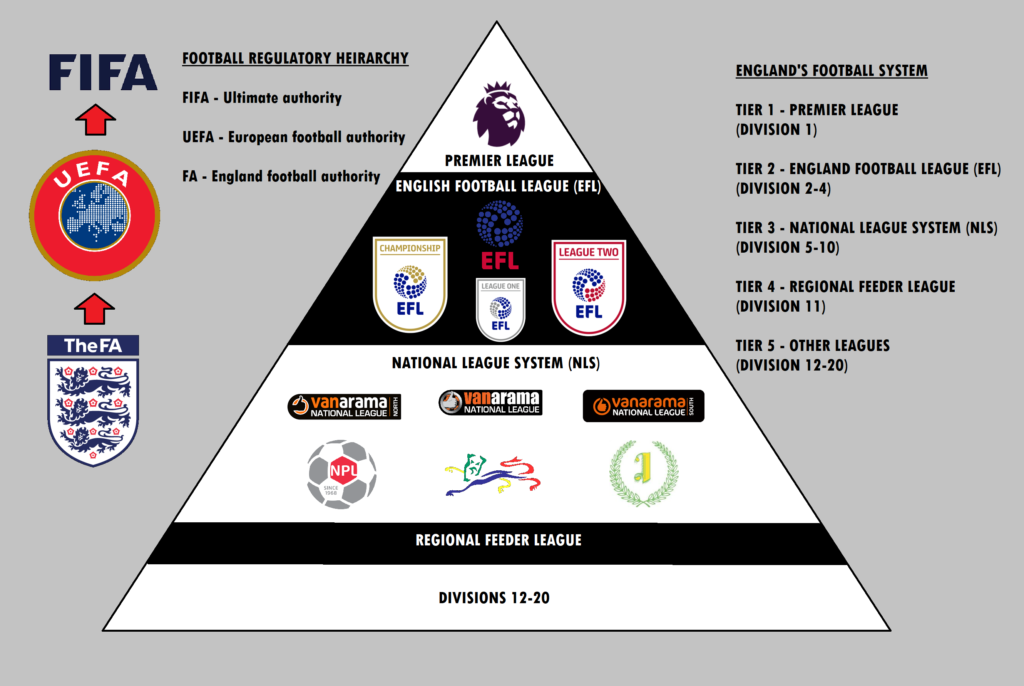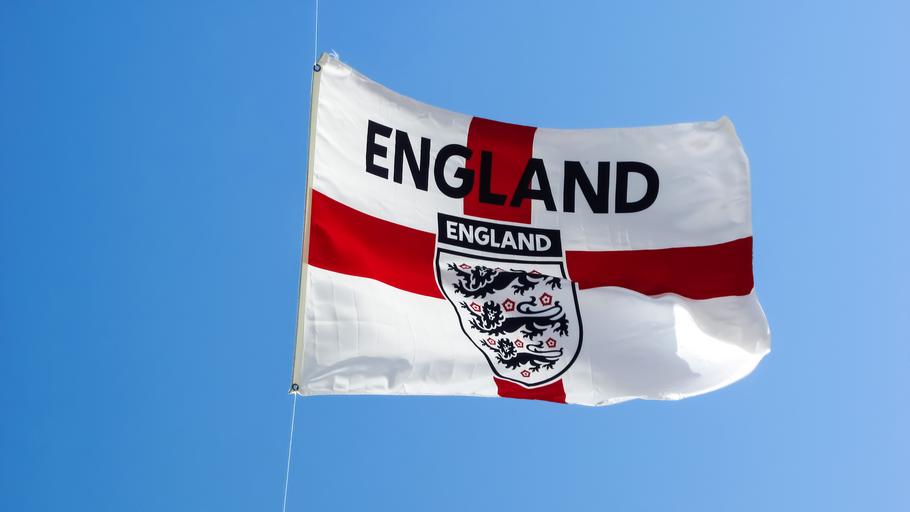ENGLAND NATIONAL FOOTBALL TEAM
FIFA RANKING: 4
GOVERNING BODY:-
The Football Association (FA)
HOME STADIUM:-
Wembley Stadium, London
CAPTAIN:-
Harry Kane
COACH:-
Gareth Southgate
MOST CAPPED PLAYER:-
Peter Shilton (125 caps)
TOP SCORER:-
Wayne Rooney (53 goals)
STAR PLAYERS:-
Harry Kane, Harry Maguire, Raheem Sterling, Jack Grealish, Jadon Sancho, Marcus Rashford
NICKNAME:-
The Three Lions
RIVALS:-
France
Germany
Republic of Ireland
Scotland
WORLD CUP:-
Appearances: 15
Best Result: Champions (1966)
EUROS:-
Appearances: 10
Best Result: 3rd (1968, 1996)

The England Squad at the 2018 FIFA World Cup in Russia (Photo: https://www.soccer.ru/galery/1057623/photo/736120, CC BY-SA 3.0)
England were the founders of association football in a sort of way. They made it a competitive sport and it was through their colonisation that the sport is so widespread and the most popular sport in the world today.
The Football Association (FA) has contributed to this success. The FA is the governing body for football in England. It is the oldest football association in the world and was established in 1863. The FA handles not only the professional football leagues in the country but also the amateur leagues.
The FA sanctions all competitive football games in England either directly or indirectly. The body is a member of both – UEFA and FIFA. It also holds a permanent seat on the International Football Association Board (IFAB) that is responsible for the laws of the game.
The England football team has always had some of the biggest names in world football with the likes of David Beckham, Steven Gerrard, Wayne Rooney and Frank Lampard in the past (to mention a few). Even now, they have some of the most talented young footballers like Jadon Sancho, Marcus Rashford and Harry Kane among others.
Yet, the team has underachieved and is thirsty for success. The Three Lions have made the final 4 of the World Cup only 3 times. Barring the 1966 World Cup win, they finished 4th in 1990 and then in 2018.
They have been pretty poor in the European Championships too. They have never made the final in Europe’s premier international competition. They finished 3rd once all the way back in 1968 and made the semi-finals in 1996 at home.
This young crop of England’s current squad, however, has looked good. They finished 3rd in the inaugural UEFA Nations League.
England has the most-watched domestic football league in the world – The Premier League. The league has the top 20 teams in England fighting it out for the title including the famed “Big 6” of Manchester United, Liverpool, Manchester City, Chelsea, Arsenal, Tottenham Hotspur and Leicester City. Everton is another team that is now in the mix of challenging for a place in Europe’s premier club competition – the UEFA Champions League.
FOOTBALL IN ENGLAND
England has the most comprehensive football system set up in the world that starts at the grassroots level itself. Football is one of England’s national sports and is the most popular sport in the country.
With over 40,000 football clubs, England has more clubs under the football laws of the game than any other country.
England has the world’s first club – Sheffield F.C., the world’s oldest professional football club – Notts County, the oldest governing body – The FA, the first national football team, the oldest knockout cup competition – The FA Cup, and the oldest football league – the English Football League.
The English Football League was established in 1888 and is the first professional football league in the world. The FA has tried to create a pyramid structure for tiering of football leagues with a promotion and relegation structure to motivate teams at the lowest levels to aspire to move up the ladder and make it into the big leagues.
Leagues

Here is the tier-system of league football in England.
Tier 1 – Premier League
The Premier League was founded in 1992 after England’s top clubs decided to break away from the English Football League to try and commercialise the sport with higher salaries for the players.
The Football League had a salary cap for players and there were many who believed that they deserved to earn more than that. The English Football League is still very much prevalent as teams get promoted from there into the Premier League every season and Premier League teams that finish in the bottom 3 have to suffer the consequences and fight it out in the second division league to come back up to the first division.
Read more here – http://www.footballbetting.org/english-premier-league/
Tier 2 – English Football League (EFL)
The second-tier of English football is the English Football League (EFL). It consists of the second division, third division and fourth division of English football.
The second division is called the EFL Championship. The English Football League Championship is the highest division of the EFL. It is contested by 24 clubs.
The top 2 teams secure automatic promotion into the Premier League while the teams that finish from 3rd to 6th, go through a playoff system to determine who secures the 3rd and final spot in the first division of English football the next season.
On the other end of the spectrum, the bottom 3 teams face the brunt of relegation to the third division.
The second division of the EFL (third division in English football) is called League One. The EFL League One like the Championship, has 24 teams and the 2 top teams secure automatic promotion. Teams that end the season in 3rd to 6th, fight it out for promotion to the division above through the playoff system. The bottom 4 teams move one level lower to the 4th division of English football.
League Two is the third and lowest division of the EFL. It is the fourth-highest division under the FA and the last division of professional clubs. It features 24 sides like the other divisions in the EFL. However, in League Two, the top 3 teams are automatically promoted with teams that finish 4th to 7th going through a playoff format to secure the 4th and final spot for promotion to League One.
The bottom 2 teams in League Two are relegated to the 3rd tier of English football – the National League.
Tier 3 – National League System
Football in England is considered “non-league” after the fourth division. At the 3rd tier sits the National League, which is the highest level of the National League System and is the 5th division of English football.
The National League has a mixture of both – professional and semi-professional clubs. The National League is the lowest division of the English football pyramid that is organised on a nationwide basis.
The league features 23 sides with the winners being automatically promoted to the EFL League Two. The 2nd spot is decided through a playoff system between the sides that finished 2nd to 7th. The bottom 4 teams are relegated to the 6th division.
The sixth division of English football is split into – National League North and National League South.
The 4 teams that are relegated from the National League are put into the respective leagues as deemed appropriate. Here, the champions in both – North and South are automatically promoted to the 5th division whereas the 2 remaining spots are fought for through a playoff system between teams that finished 2nd to 7th in each league.
Here, the bottom 2 teams in each zone (North and South) are relegated to either the Northern Premier League, Southern League or Isthmian League as appropriate.
The 7th division of English football is split into 4 leagues –
- Northern Premier League Premier Division,
- Southern Football League Central Division,
- Southern Football League South Division
- Isthmian League Premier Division
These leagues have 22 teams in each of them. The champions in each division are automatically promoted while the next 4 teams in the table compete in the playoffs to secure the 2nd promotion spot. The bottom two teams in each division and two 20th-placed teams with the lowest Points Per Game ratio, are relegated to the 8th division.
The 8th division is even further split into 7 leagues –
- Northern Premier League Division One North
- Northern Premier League Division One South
- Southern Football League Division One East
- Southern Football League Division One West
- Isthmian League Division One North
- Isthmian League Division One South Central
- Isthmian League Division One South East
There are 20 teams in each of these leagues with the champions from each getting promoted with the next 4 teams in their respective tables facing off for the other promotion spot. The bottom team in each of the leagues in the 8th division must play a 9th division runner-up club in a one-off game to secure their place in the 8th division.
The National League System (NLS) has 2 more divisions after this that are handled by them.
The 5th division in the NLS is the 9th division of English football. It is made up of the following leagues:
- Combined Counties League Premier Division
- Eastern Counties League Premier Division
- Essex Senior League
- Hellenic League Premier Division
- Midland League Premier Division
- North West Counties League Premier Division
- Northern Counties East League Premier Division
- Northern League Division One
- Southern Counties East League Premier Division
- Spartan South Midlands League Premier Division
- Southern Combination Premier Division
- United Counties League Premier Division
- Wessex League Premier Division
- Western League Premier Division
The 6th and final division of the NLS is the 10th division of English football. It is divided into the below leagues:
- Combined Counties League Division One
- East Midlands Counties League
- Eastern Counties League Division One North
- Eastern Counties League Division One South
- Hellenic League Division One East
- Hellenic League Division One West
- Midland League Division One
- Northern Counties East Division One
- Northern League Division Two
- North West Counties League Division One North
- North West Counties League Division One South
- Southern Counties East League Division One
- South West Peninsula League Premier Division East
- South West Peninsula League Premier Division West
- Spartan South Midlands League Division One
- Southern Combination Division One
- United Counties League Division One
- Wessex League Division One
- West Midlands (Regional) League Premier Division
- Western League Division One
The 11th division known as the Regional Feeder League, is the last defined league in the system.
There are 9 more leagues in the English football system making it a total of 20 leagues in the country, however, these are not properly defined and follow a notional structure.
England has a number of clubs that play football at an “amateur” level, that is, with no financial reward.
After the regional levels, which are majorly divided into 3 – Northern Premier League, Southern League and Isthmian League, county football is widespread in the country.
County Football Associations are the local governing bodies for football in England. They are in charge of the famed Sunday League. The Amateur Football Alliance (AFA) is the largest organised amateur football competition that is very popular in and around London.
The Sunday League is also popularly referred to as the Pub League as there are several pubs that form teams and play football every weekend.
Reserve Leagues are a big deal in England. These are sides that are fielded by the top professional clubs in England to compete in the Premier Reserve League.
Youth Leagues are another common theme for professional clubs to have. The highest level of youth football is the Premier Academy League, which is for all Premier League and Football League clubs that have academy teams.
The league has 40 clubs divided into 4 groups, equally. The winners of each group then face-off in a playoff tournament to determine the winner of the league.
There is a second division in youth football known as the Football League Youth Alliance. This league features those youth teams whose clubs have “Centres of Excellence” status. The league has 58 teams, divided into 4 regional conference leagues.
Cups
| Level | League(s) | The FA Cup | EFL Cup | EFL Trophy | FA Trophy | FA Vase |
| 1 | Premier League | Yes | Yes | Academies | No | No |
| 2 | EFL Championship | Yes | Yes | Academies | No | No |
| 3 | League One | Yes | Yes | Yes | No | No |
| 4 | League Two | Yes | Yes | Yes | No | No |
| 5 | National League Top Division | Yes | No | No | Yes | No |
| 6 | National League – North & South | Yes | No | No | Yes | No |
| 7 | Northern Premier League (NPL), Southern Leagues (SFL), Isthmian League (IL) Premier Division |
Yes | No | No | Yes | No |
| 8 | NPL, SFL, IL Division One | Yes | No | No | Yes | No |
| 9 | Regional Clubs | Yes | No | No | No | Yes |
| 10 | Regional Clubs | Yes | No | No | No | Yes |
| 11 | Regional Feeder League | No | No | No | No | Yes |
England’s cup competition eligibility is also determined by league status. The oldest knockout competition in football – the FA Cup features teams from the top division (the Premier League) to the 10th division (the last league in the National League System).
- FA Cup – Levels 1 to 10
- EFL Cup – Levels 1 to 4
- EFL Trophy – Levels 3 and 4
- FA Trophy – Levels 5 to 8
- FA Vase – Levels 9 and 10
- FA Inter-League Cup – Level 11 (features representative teams from each league in the Regional Feeder League)
In the case of the FA Cup and the FA Vase, some clubs from the lowest level miss out on competing as they do not qualify given the limit on numbers.
Below Level 11, the football pyramid becomes regional and these teams then contest for their regional cups. Further down the pyramid is a split by county and even they have their own cup competitions.
Apart from the Football League Youth Alliance, the Youth Alliance also organises cup football – the Youth Alliance Cup is an annually run competition for its youth teams.
The FA Youth Cup is a nationwide cup competition for Under-18 teams organised by the FA. There are over 400 clubs that enter the knockout competition each season!
European Competitions
UEFA Champions League
The UEFA Champions League is the premier club competition for European clubs. The teams that finish in the top 4 of the Premier League secure qualification into the UEFA Champions League.
English teams can also get direct entry into the UEFA Champions League by winning the Champions League or the Europa League.
UEFA Europa League
The Europa League is the second division of European club football. The FA Cup winners secure a place into the Europa League group stage alongside the team that finishes 5th in the Premier League.
In case the FA Cup-winning team has already secured a spot in the Champions League or Europa League by finishing in the Top 5 then the 6th placed team qualifies for the tournament.
The EFL Cup winners also secure their spot in the Europa League second-qualified round unless they have finished in the top 5 places. If that is the case then the next highest-ranked team in the Premier League gets to compete in the Europa League.

